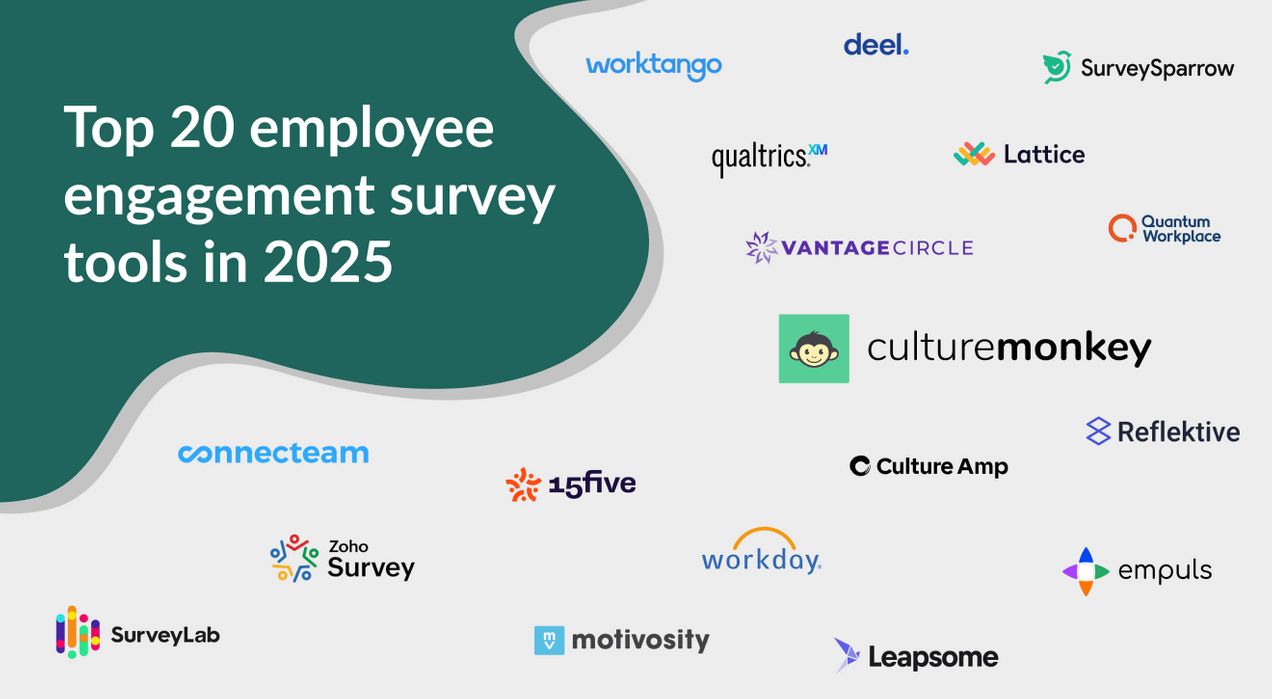50+ Relevant annual employee survey questions to ask your workforce in 2025

Think of your workplace like a car engine. It might hum along smoothly, but without regular diagnostics, how do you know if everything’s running efficiently? The annual employee survey is your check engine light—alerting you to potential issues before they cause a breakdown.
In 2025’s fast-paced work environment, with hybrid setups and evolving employee expectations, some wonder if this “diagnostic tool” is outdated. But the reality is, skipping it could mean missing early signs of disengagement, burnout, or communication gaps that could stall your team’s progress.
In fact, Gallup estimates that disengaged employees cost U.S. companies between $450 billion to $550 billion annually in lost productivity.
When done right, the annual survey doesn’t just highlight problems—it provides the insights needed to fine-tune your workplace for peak performance. So, is it still relevant? Absolutely. Let’s explore how this trusted tool continues to drive engagement and innovation in today’s ever-changing work landscape.
What is an employee engagement survey?
An employee engagement survey is a powerful tool used by organizations to measure and understand the level of employee commitment, satisfaction, and motivation within the workplace.
These surveys are designed to provide actionable insights into how employees feel about various aspects of their work environment, leadership, team dynamics, and the organization’s culture. By gauging these factors, companies can identify areas that need improvement to foster a more engaged and productive workforce.
Typically, an employee engagement survey consists of a well-structured employee survey questionnaire covering topics like communication, career development, recognition, and overall job satisfaction. The questions are crafted to elicit honest and meaningful feedback from employees, ensuring that the responses reflect their true experiences and opinions.
Unlike one-time feedback mechanisms, employee engagement surveys are often part of a broader strategy, such as a company survey, to monitor organizational health over time.
Regularly conducting these surveys demonstrates a company’s commitment to valuing employee input, creating a positive workplace, and driving continuous improvement.
In essence, an employee engagement survey serves as a bridge between leadership and employees, enabling open communication and fostering a culture of collaboration and trust.
What is an annual employee engagement survey?

An annual employee engagement survey is a structured assessment conducted by organizations to gauge the level of engagement and satisfaction among their employees. It involves collecting feedback from employees regarding various aspects of their work experience, such as job satisfaction, communication, leadership, teamwork, and organizational culture.
The survey aims to measure the overall level of employee engagement and identify areas for improvement within the company culture.
Typically, an annual employee engagement survey consists of a series of questions that employees are asked to respond to anonymously.
The questions may cover topics such as their level of satisfaction with their job, opportunities for growth and development, recognition and rewards, work-life balance, and the effectiveness of internal communication channels.
The survey results provide valuable insights into the overall health of the organization and its workforce. They help identify strengths and weaknesses, as well as potential areas of concern.
By understanding the factors that contribute to employee engagement, organizations can take targeted actions to enhance the work environment, foster a positive culture, and increase overall employee satisfaction. An annual employee engagement survey is an essential tool for organizations to measure and monitor employee engagement over time.
How do annual employee surveys work?

Annual employee surveys are conducted by organizations to gather feedback from their employees regarding various aspects of their work experience.
The process typically involves the following steps:
- Designing the survey: Organizations develop a questionnaire that includes a range of questions aimed at assessing their employee engagement levels, satisfaction, and other relevant factors. The questions may cover areas such as job satisfaction, communication, leadership, teamwork, and organizational culture.
- Distribution: The survey is distributed to all employees, often through an online platform or email. Employees are typically assured of anonymity to encourage honest responses.
- Data collection: Employees complete the survey by responding to the questions provided. The survey period is typically defined, and employees are given a specific deadline to submit their responses.
- Data analysis: Once the survey period ends, the collected data is analyzed to identify patterns, trends, and areas of concern. Statistical methods may be used to analyze the data and derive meaningful insights.
- Reporting and action planning: The annual engagement survey results are compiled into a report that highlights key findings and recommendations. This report is shared with management and relevant stakeholders. Based on the results, organizations develop action plans to address identified areas of improvement and enhance employee engagement.
- Follow-up: Organizations may communicate the survey results to employees and outline the actions planned in response to the feedback. Regular follow-up surveys may be conducted in subsequent years to track progress and measure the effectiveness of implemented initiatives.
Importance of conducting an annual employee survey

Conducting an annual employee survey holds significant importance for organizations. Here are some key reasons why:
Measure employee engagement
An annual employee survey provides a systematic and structured approach to measuring the level of employee engagement within the organization.
It helps gauge how committed, motivated, and satisfied employees are with their work, providing valuable insights into the overall health of the workforce.
Identify areas for improvement
The survey results help identify specific areas where the organization can improve its policies, practices, and work environment. Organizations can address issues that may hinder engagement, productivity, and overall employee performance, by understanding employee concerns and feedback.
Enhance employee satisfaction
A well-designed survey enables organizations to gather feedback on various aspects of the work experience, including job satisfaction, work-life balance, career growth opportunities, and communication.
This information can guide initiatives to enhance employee satisfaction, leading to higher morale and retention.
Make data-driven decisions
An annual employee survey provides organizations with quantitative and qualitative data that can be analyzed to make informed decisions.
It helps leaders understand the impact of their actions, prioritize initiatives, and allocate resources effectively to areas that will have the most significant positive impact on employee engagement.
Track progress and trends
Conducting these engagement surveys annually allows organizations to track changes in employee engagement over time. By comparing survey results year after year, organizations can identify trends, measure the effectiveness of implemented initiatives, and monitor progress toward improving employee engagement.
Demonstrate commitment to employees
Regularly conducting employee surveys sends a clear message to employees that their opinions matter and that the organization is committed to creating a positive work environment. This can foster trust, open communication, and a sense of belonging among employees.
Refine employee survey questions
Crafting clear and targeted employee survey questions ensures that the collected feedback accurately reflects employees' experiences and needs. Thoughtful questions enhance the quality of insights and enable organizations to pinpoint critical areas requiring attention.
Strengthen associate engagement survey efforts
Incorporating an associate engagement survey into annual evaluations deepens understanding of team dynamics and individual contributions. This approach provides a comprehensive view of engagement levels across different departments and teams, driving tailored strategies for improvement.
Leverage surveys for employees to shape policies
Surveys for employees offer a direct channel for gathering input on workplace policies and practices. This feedback can help refine existing policies or develop new ones that resonate more closely with employee expectations, fostering a more inclusive work culture.
Improve survey for employees participation rates
Focusing on enhancing surveys for employee participation ensures diverse and representative feedback. Encouraging higher response rates through transparent communication and incentivization amplifies the reliability of survey results, making them more actionable for organizational development.
Key metrics your annual employee survey needs to measure

When conducting an annual employee survey, it is crucial to measure key metrics that provide meaningful insights into the organization's workforce. Here are some essential metrics to consider:
- Employee engagement: Measure the level of employee engagement through questions that assess their emotional commitment, motivation, and willingness to go the extra mile. This metric helps gauge the overall satisfaction and dedication of employees.
- Job satisfaction: Assess employees' contentment with their roles, responsibilities, and the work environment. Understanding their level of job satisfaction provides insights into areas that may need improvement to enhance overall morale.
- Communication effectiveness: Evaluate how well information flows within the organization. Measure employees' perception of the clarity, frequency, and transparency of communication from management, as well as the availability of channels for feedback.
- Leadership effectiveness: Evaluate employees' confidence in their leaders and their ability to inspire, guide, and support them. Measure the perception of leadership skills, accessibility, and manager effectiveness.
- Career development opportunities: Determine if employees feel they have opportunities for growth and advancement within the organization. Assess their satisfaction with training programs, career paths, and support for skill development.
- Work-life balance: Measure employees' perception of work-life balance and their ability to manage personal and professional responsibilities. This metric provides insights into the organization's support for employee well-being.
- Diversity and inclusion: Assess employees' perception ofdiversity and inclusion efforts within the organization. Measure their sense of belonging, equal opportunities, and inclusion in decision-making processes.
These insights will enable informed decision-making and targeted actions to foster a positive and productive work environment, leading to increased employee satisfaction, retention, and organizational success.
What kind of employee survey should you be using?

Choosing the right type of employee survey depends on your organizational goals and the insights you aim to gather. Here are five different needs and the ideal survey types to address them:
1. For gauging overall engagement
An annual employee engagement survey is ideal for measuring comprehensive employee sentiment across areas like satisfaction, leadership, and career development. These surveys provide deep insights into long-term engagement trends and help plan large-scale improvements.
2. When you need regular insights into employee sentiment
Employee engagement pulse surveys are ideal for gathering quick, ongoing feedback on specific topics such as workload, well-being, or recent initiatives. These short surveys, conducted weekly or monthly, help track engagement trends and identify immediate concerns, enabling timely action.
3. For tracking morale during organizational changes
If your company is undergoing significant transitions, such as restructuring or mergers, a change management survey can help understand how employees feel about these changes. This ensures smoother adaptation and helps mitigate resistance.
4. For assessing inclusion and diversity
A Diversity, Equity, and Inclusion (DEI) survey is essential for understanding employees' experiences related to fairness, representation, and inclusion. This survey highlights areas where policies and practices can be improved to foster a more inclusive environment.
5. For improving team dynamics
If the focus is on team collaboration and alignment, a team effectiveness survey can help identify communication gaps, role clarity issues, or team-specific challenges. This feedback is vital for building stronger, more cohesive teams.
Employee engagement: The stats bit to know in 2025
- According to a survey by Business Insider, 73% of the 2,099 respondents considering their employment plans are contemplating quitting. Over a quarter of them expressed they would feel comfortable leaving their job without having another one secured.
- Gallup found that work units in the top quartile of employee engagement outperformed those in the bottom quartile by 10% in customer ratings, 22% in profitability, and 21% in productivity.
- In the latest Gallup report, 51% of employees are classified as disengaged, while 13% are actively disengaged, meaning they not only feel miserable at work but also spread negativity among their colleagues.
- A survey by Korn Ferry revealed that 33% of employees leave their jobs because they feel bored and seek new challenges. They are driven by the desire for greater opportunities for professional development.
- Forbes reports that one-third of Americans believe their work is negatively affecting their mental health, with 80% of them stating they experience stress at work.
What is a pulse survey? How can it complement the annual employee survey?

A pulse survey is a short, focused questionnaire designed to gather quick insights on specific topics, such as employee morale, engagement, or feedback on recent initiatives. Unlike annual surveys, pulse surveys are conducted more frequently, often monthly or quarterly, to track employee sentiment in real-time.
They are concise, easy to complete, and provide actionable data, making them a valuable tool for organizations seeking to stay connected to their workforce.
While annual employee surveys are comprehensive and provide a big-picture view of engagement and satisfaction, pulse surveys complement them by offering timely updates between annual assessments. For example, if an annual survey identifies areas requiring improvement, pulse surveys can be used to monitor the progress of corrective actions and gauge their effectiveness over time.
By using both types of surveys, organizations can maintain a balance between in-depth analysis and regular check-ins. Pulse surveys capture the immediate pulse of the workforce, helping organizations address emerging issues before they escalate.
What is the difference between a pulse survey and an annual survey?
| Aspect | Engagement Pulse Survey | Annual Survey |
|---|---|---|
| Frequency | Conducted frequently, such as monthly, quarterly, or even weekly. | Conducted once a year, providing a snapshot of overall engagement. |
| Purpose | Primarily used to track immediate or short-term engagement trends and issues. | A comprehensive survey aimed at gathering long-term engagement data. |
| Length | Typically short, with 5 to 15 focused questions. | Longer in length, often containing 30 to 50 or more questions on various topics. |
| Response Time | Designed for quick responses, usually completed in 2-5 minutes. | Requires more time, often 20-30 minutes, to answer in detail. |
| Insights | Provides fast, actionable feedback on specific issues or initiatives. | Offers a broad, deep analysis of engagement trends over the past year. |
| Focus Areas | Focused on specific aspects of employee engagement or recent changes. | Covers a wide range of areas, from work culture to leadership and development. |
| Data Analysis | Results are analyzed quickly to allow organizations to take immediate action. | Data is analyzed in-depth to identify trends, strengths, and areas for improvement over the long term. |
Both engagement pulse surveys and annual surveys are essential for understanding employee engagement. While pulse surveys for employee engagement provide regular, short-term insights into specific issues, annual surveys offer a broader, long-term perspective on overall engagement levels.
By using both methods, organizations can continuously monitor employee satisfaction, track trends, and take prompt action based on real-time feedback, ensuring sustained improvement in engagement.
50+ Annual employee survey questions you should ask in 2025

When crafting an annual employee survey, it's important to ask the right questions to gather comprehensive feedback and insights from your workforce.
Here are 50+ sample questions to consider for your 2025 annual employee survey:
- Overall, how satisfied are you with your job?
- Do you feel valued and appreciated for your contributions?
- How would you rate the level of communication within the organization?
- Do you receive regular feedback and recognition for your work?
- Are you satisfied with the opportunities for professional growth and development?
- How well does your immediate supervisor support your success?
- Are you clear about your roles and responsibilities?
- How satisfied are you with the work-life balance in the organization?
- Do you feel the organization promotes a culture of diversity and inclusion?
- Are you satisfied with the level of transparency in decision-making processes?
- How would you rate the effectiveness of internal communication channels (e.g., email, intranet)?
- Do you feel the organization listens and responds to employee feedback?
- Are you satisfied with the benefits and perks offered by the organization?
- How well does the organization support your physical and mental well-being?
- Are you provided with the necessary resources and tools to perform your job effectively?
- How satisfied are you with the opportunities for collaboration and teamwork?
- Do you feel your ideas and suggestions are taken seriously?
- How well does the organization promote a healthy work environment?
- Are you satisfied with the organization's approach to working flexibility (e.g., remote work, flexible hours)?
- How well do company values align with your personal values?
- Do you feel there are equal opportunities for career advancement within the organization?
- How would you rate the level of trust between employees and management?
- Are you satisfied with the performance evaluation and feedback processes?
- How well does the organization support continuous learning and skill development?
- Do you feel the organization promotes healthy work-life integration?
- Are you satisfied with the level of autonomy and decision-making authority in your role?
- How would you rate the organization's commitment to corporate social responsibility?
- Do you have a clear understanding of the organization's strategic goals and objectives?
- Are you satisfied with the organization's approach to work-related stress management?
- How well does the organization recognize and appreciate work-life balance needs?
- Do you feel the organization fosters a sense of belonging and community?
- Are you satisfied with the level of transparency in performance evaluation and promotion processes?
- How likely are you to recommend the organization as a great place to work?
- How well does the organization encourage innovation and creative thinking?
- Are you satisfied with the training programs provided by the organization?
- Do you feel your workload is manageable and realistic?
- How effectively does the organization communicate changes and updates?
- Are you satisfied with the opportunities to participate in decision-making processes?
- How well does the organization support career transitions or internal mobility?
- Do you feel there is effective collaboration across departments?
- Are you satisfied with the organization's conflict resolution processes?
- How would you rate the quality of leadership in the organization?
- Do you feel your work contributes to the overall success of the organization?
- Are you satisfied with the way the organization handles employee concerns or grievances?
- How well does the organization ensure workplace safety and security?
- Do you feel you have opportunities to share and develop your skills outside of your core responsibilities?
- How satisfied are you with the onboarding process for new employees?
- Do you feel the organization supports a positive work culture?
- Are you satisfied with the level of feedback and coaching provided by your supervisor?
- How effectively does the organization handle diversity-related issues?
- Do you feel the organization's mission and vision resonate with you?
- Are you satisfied with the organization's approach to technology and tools?
- How well does the organization celebrate and reward achievements?
Common mistakes to avoid in conducting your annual employee survey

When conducting your annual employee survey, it's crucial to avoid common mistakes that can undermine the effectiveness and validity of the results.
Here are some pitfalls to steer clear of:
- Vague or ambiguous questions: Ensure that survey questions are clear, specific, and easy to understand. Ambiguity can lead to confusion and inaccurate responses.
- Leading or biased questions: Avoid questions that steer employees toward a particular response or contain implicit biases. Keep employee engagement questions neutral and unbiased to gather unbiased feedback.
- Survey length overload: Long surveys can lead to survey fatigue and lower response rates. Keep your survey concise and focused on essential topics to maximize participation and engagement.
- Lack of anonymity and confidentiality: Assure employees that their responses will be anonymous and confidential. This fosters trust and encourages honest feedback.
- Poor survey timing: Choose the timing of your survey thoughtfully. Avoid busy periods or times when employees might feel rushed or overwhelmed. Consider their workload and schedules for optimal participation.
- Inadequate communication: Properly communicate the purpose, importance, and benefits of the annual employee satisfaction survey questions to employees. Lack of communication can result in low engagement and incomplete responses.
- Failure to act on survey findings: Survey results are valuable only if actions are taken based on the feedback received. Create a plan to address issues in employee survey results and communicate progress to employees.
- Ignoring demographic diversity: Analyze survey results by demographic groups (e.g., age, gender, department) to identify potential disparities and ensure inclusivity in your actions.
- Overlooking qualitative feedback: While quantitative data is important, don't ignore the qualitative feedback provided by employees. Rich insights can be obtained from open-ended questions and comments from engaged employees.
- Lack of follow-up: Keep employees informed about the survey results, actions taken, and progress made. Continuous communication demonstrates a commitment to their feedback and encourages future participation.
The best employee engagement survey questions
Effective employee engagement surveys rely on carefully crafted questions that address key areas of workplace satisfaction, motivation, and commitment. Here are 10 essential questions, along with the reasons they’re asked:
- How satisfied are you with your role and responsibilities? - This question gauges overall job satisfaction and helps identify potential mismatches between employee expectations and assigned duties.
- Do you feel valued and recognized for your work? - Understanding whether employees feel appreciated highlights gaps in recognition programs and improves morale.
- How effective is communication within your team and across the organization? - This question identifies communication barriers that might hinder collaboration and productivity.
- Do you have the tools and resources needed to perform your job effectively? - It ensures employees are equipped to meet expectations, addressing potential obstacles to performance.
- Are your career growth and development goals supported by the organization? - This reveals if employees see opportunities for advancement, a critical factor in retention.
- Do you feel your opinions and ideas are valued? - This measures psychological safety and fosters a culture of inclusion and innovation.
- How satisfied are you with the work-life balance provided by the organization? - This question uncovers stress points that could affect engagement and productivity.
- Do you trust the leadership of the company? - Trust in leadership is a cornerstone of employee engagement and organizational success.
- Do you believe the company’s values align with your personal values? - This examines cultural fit, which greatly influences engagement levels.
- Would you recommend this organization as a great place to work? - This serves as a proxy for overall employee satisfaction and loyalty.
7 Types of questions to avoid in your employee engagement survey
1. Overly complex questions
- Example: "How satisfied are you with the comprehensive strategic alignment of your team goals and overall organizational objectives?"
- Why: Questions that are too wordy or contain jargon confuse employees, leading to inaccurate or incomplete responses. Keep language simple and clear.
2. Double-barreled questions
- Example: "Do you feel valued by your manager and have adequate opportunities for professional growth?"
- Why: These combine two topics into one question, such as “Do you feel valued and have opportunities for growth?” Respondents may struggle to answer accurately if they have different opinions on each topic.
3. Leading questions
- Example: "Don’t you agree that the leadership team does an excellent job?"
- Why: Questions that suggest a particular answer, like “Do you agree that management is always supportive?” can bias responses and skew results.
4. Overly broad questions
- Example: "Are you happy at work?"
- Why: General questions lack context, making it difficult to derive actionable insights.
5. Irrelevant questions
- Example: "What’s your favorite vacation destination?"
- Why: Questions unrelated to the workplace or engagement distract respondents and waste their time. Focus on questions that align with survey goals."
6. Negatively framed questions
- Example: "What do you hate most about your job?"
- Why: Negatively worded questions create a pessimistic tone and may discourage honest feedback.
7. Excessive open-ended questions
- Example: "Describe your feelings about every aspect of your work environment."
- Why: While open-ended questions can provide insights, too many can overwhelm employees and reduce participation rates. Balance them with closed-ended ones.
How can organizations increase participation in annual employee surveys?

- Communicate the importance: Clearly explain the purpose and impact of the survey. When employees understand that their feedback will drive meaningful change, they are more likely to participate.
- Ensure anonymity: Guarantee confidentiality to foster honest responses. Employees should feel safe sharing their opinions without fear of repercussions.
- Make it accessible: Use multiple channels to distribute the survey (email, mobile, company intranet), ensuring it’s accessible to all employees, including remote workers.
- Keep it short and focused: Limit the length of the survey to avoid overwhelming employees. Focus on key areas of employee engagement to maintain relevance and clarity.
- Offer incentives: Reward employees for completing the survey, such as with gift cards, extra time off, or a raffle. Incentives can boost participation rates.
- Send reminders: A gentle reminder halfway through the survey period can help boost response rates, especially if employees are busy or forget about it.
- Act on the feedback: Employees are more likely to participate if they know their feedback will lead to real change. Demonstrate how the survey results are used to improve workplace policies or practices, fostering a sense of involvement.
The importance of your survey question scale?
The scale you use in your survey questions, such as the Likert scale, plays a vital role in gathering accurate and actionable feedback. A well-chosen scale helps quantify subjective opinions, enabling organizations to make data-driven decisions. Here are five key reasons why the question scale is crucial:
- Standardizes responses: Using a consistent scale, like a 5-point Likert scale, ensures that all responses are measured uniformly. This standardization allows for easier analysis and comparison of data across various groups or time periods.
- Captures nuanced feedback: A survey question scale provides respondents with a range of options to express their level of agreement, satisfaction, or experience. This flexibility helps capture subtle variations in feedback, offering deeper insights into employee sentiments.
- Increases data reliability: Scales like the Likert scale improve the reliability of survey data by reducing ambiguity in responses. Clear, structured options prevent misinterpretation and ensure that feedback accurately reflects employee opinions.
- Enhances survey engagement: Respondents find scaled questions easier and quicker to answer, improving participation rates and overall survey engagement. A well-designed scale fosters a positive survey experience, encouraging honest feedback.
- Facilitates trend analysis: Using the same question scale over time enables organizations to track changes and trends in engagement or satisfaction. This consistency provides valuable insights into the long-term impact of initiatives and strategies.
What to do after measuring employee engagement using an annual employee survey?

After measuring employee engagement using an annual employee survey, it is crucial to take actionable steps to address the findings and foster a positive work environment.
Here are key actions to consider:
- Analyze and interpret the results: Thoroughly analyze the survey data to identify trends, patterns, and areas of concern. Interpret the findings in the context of your organization's goals, values, and culture.
- Communicate the results: Share the survey results with employees in a transparent and timely manner. Acknowledge the feedback received and express appreciation for their participation. Clearly communicate the next steps and how the feedback will be used to drive positive change.
- Develop an action plan: Based on the survey findings, create a comprehensive action plan. Prioritize areas that require improvement and set specific, measurable, attainable, relevant, and time-bound (SMART) goals. Assign responsibilities and establish a timeline for implementing the initiatives.
- Involve employees in the process: Engage employees in the action planning phase. Seek their input, ideas, and suggestions for improvement. This fosters a sense of ownership, increases buy-in, and ensures that initiatives address their needs effectively.
- Implement initiatives and monitor progress: Execute the action plan and monitor progress regularly. Provide necessary resources and support to facilitate the implementation of initiatives. Track key metrics and indicators to assess the impact of the implemented changes.
- Foster a culture of continuous improvement: Employee engagement is an ongoing process. Encourage constant feedback and dialogue throughout the year, beyond the annual survey. Regularly assess the effectiveness of initiatives and make adjustments as needed.
- Celebrate successes and recognize efforts: Celebrate milestones and successes achieved through engagement initiatives.Recognize and appreciate individuals and teams who have contributed to positive changes. This reinforces a culture of appreciation and motivates further engagement.
Choosing an employee engagement survey vendor
Selecting the right employee engagement survey vendor is a critical decision that can impact the success of your engagement initiatives. Follow these 10 steps to make an informed choice:
- Define your objectives: Clarify your goals for the survey, such as improving engagement, identifying pain points, or tracking trends, to ensure the vendor can meet your needs.
- Assess the vendor’s expertise: Evaluate the employee engagement survey vendor’s experience in conducting workplace surveys, especially within your industry, to ensure their insights are relevant.
- Review survey customization options: Look for a vendor that offers flexibility to tailor surveys to your company’s culture, goals, and specific employee needs.
- Check data security measures: Ensure the vendor adheres to stringent data protection standards to safeguard employee voice and maintain confidentiality.
- Examine reporting capabilities: The vendor should provide intuitive, detailed reports with actionable insights to help you make data-driven decisions.
- Evaluate technology and tools: Assess the survey platform’s usability, mobile compatibility, and integration options with your existing systems.
- Look for post-survey support: Ensure the vendor offers guidance on interpreting results and implementing engagement strategies after the survey is completed.
- Seek scalability: Choose a vendor capable of scaling surveys to match your organization’s growth or changes in workforce size.
- Consider pricing and ROI: Compare pricing models to ensure the vendor offers good value and measurable return on investment.
- Check references and reviews: Request testimonials or case studies from other clients to validate the vendor’s credibility and performance.
Significance of annual employee engagement survey software in understanding long-term trends

- Provides a comprehensive view of employee sentiment: Annual employee engagement surveys offer a detailed snapshot of employee attitudes, satisfaction, and concerns. By collecting data on various aspects of the work environment, these surveys help HR teams gauge overall engagement levels and track changes over time.
- Tracks long-term trends in employee engagement: Unlike short-term feedback, annual surveys allow organizations to monitor engagement trends across multiple years. This helps identify patterns, whether positive or negative and provides insights into how workplace culture evolves, allowing leaders to plan for the future effectively.
- Identifies emerging issues: Employee engagement software helps uncover issues that may not be immediately obvious but could indicate growing concerns. These trends can be related to management practices, work-life balance, or company policies that, if not addressed, could escalate into larger problems.
- Supports data-driven decision-making: By consolidating and analyzing data from year to year, annual surveys provide valuable metrics that HR and management teams can use to make informed, strategic decisions. This data-driven approach ensures that interventions are based on solid evidence, not assumptions.
- Facilitates targeted improvements: Tracking long-term trends allows companies to prioritize initiatives that address areas of decline or areas that impact employee morale. Annual staff surveys provide a clear framework for organizations to evaluate the effectiveness of implemented changes and make necessary adjustments.
Conclusion
Conducting an annual employee survey is essential for understanding the evolving needs and sentiments of your workforce.
By regularly gathering feedback, organizations can identify trends, pinpoint areas for improvement, and make informed decisions that foster a positive work environment.
CultureMonkey’s annual employee engagement survey offers a comprehensive, AI-driven solution for understanding your workforce's needs and improving engagement. With its multilingual surveys, customizable templates, and omni-channel survey reminders, CultureMonkey ensures high participation rates and inclusive feedback from a diverse employee base.
The platform's advanced analytics, powered by People Science, help you track trends over time, compare survey results year-over-year, and benchmark against industry standards.
AI-generated action recommendations provide tailored strategies for addressing employee concerns, fostering an environment where continuous improvement is prioritized.
With features like easy-to-understand insights and actionable reports, CultureMonkey empowers HR teams to implement strategies that enhance employee satisfaction, engagement, and retention. By utilizing CultureMonkey, organizations can ensure a healthier workplace culture that drives long-term success.
FAQs
1. Are annual employee surveys still relevant in 2025?
Annual employee surveys remain highly relevant in 2025 as they provide a comprehensive view of workforce sentiment, engagement, and organizational health. While pulse surveys offer real-time insights, annual surveys capture deeper, strategic trends over time. They help organizations evaluate the impact of long-term initiatives, ensure alignment with evolving goals, and foster a culture of continuous improvement and employee engagement.
2. In the era of real-time feedback and pulse surveys, why should organizations continue with annual surveys?
In an age dominated by real-time feedback and pulse surveys, annual surveys remain vital for capturing broad, strategic insights. They provide a holistic overview of employee engagement, track long-term trends, and evaluate the effectiveness of organizational initiatives. Annual surveys complement pulse surveys by offering depth, ensuring organizations can balance immediate needs with comprehensive, data-driven decision-making for sustainable growth.
3. What is the ideal length of an annual employee survey to ensure high completion rates?
The ideal length for an annual employee survey is typically between 15 to 30 questions. This balance ensures comprehensive feedback while maintaining respondent engagement. Shorter surveys may miss key insights, while longer ones can overwhelm employees. Keeping surveys concise and focused encourages higher completion rates, providing valuable data without causing survey fatigue.
4. Do annual surveys consider the evolving focus on employee well-being and mental health?
Yes, annual surveys increasingly focus on employee well-being and mental health. By including questions on stress levels, work-life balance, and support for mental health, these surveys capture insights into how well organizations address employee wellness. This evolving focus helps companies identify areas for improvement, ensure a supportive work environment, and promote overall well-being among their workforce.
5. How do annual surveys contribute to improving employee retention?
Annual surveys contribute to improving employee retention by providing insights into factors that influence job satisfaction, engagement, and morale. By identifying areas where employees may feel dissatisfied or unsupported, organizations can implement targeted strategies to address concerns, improve workplace culture, and offer better career development opportunities, ultimately increasing employee loyalty and reducing turnover.
6. Are employee surveys a good idea?
Employee surveys are a great idea for organizations aiming to enhance engagement and productivity. Tools like an associate engagement survey provide actionable insights into employee satisfaction, morale, and workplace concerns. By asking well-designed staff survey questions, companies can foster open communication, identify areas for improvement, and build a positive work environment that supports both employee well-being and organizational success.
7. What is the end-of-year survey for staff?
An end-of-year survey for staff is a structured way to gather feedback on workplace experiences, achievements, and challenges over the past year. Similar to an associate engagement survey, year-end survey questions for employees help assess their satisfaction and engagement. By including thoughtful staff survey questions, organizations can identify improvement areas, plan for the future, and ensure a supportive and productive environment.



